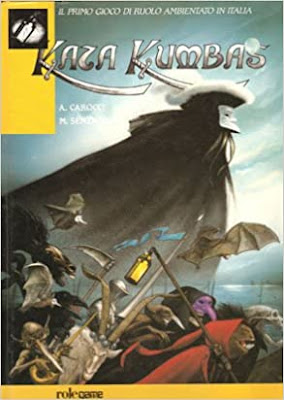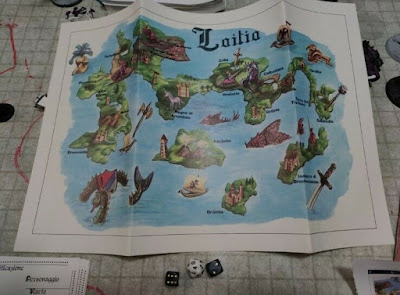 |
| Second edition cover by John Howe |
Designed by Agostino Carrocci and Massimo Senzacqua, Kata Kumbas was the second Italian language roleplaying game ever published. It first appeared in 1984 just a few months after I Signori del Caos. Unlike its predecessor, Kata Kumbas featured an original rules system – I Signori del Caos was derivative of AD&D – and, more importantly, a setting based on a fantastical version of Italy (or Laitia). Laitia has many inspirations, from Orlando Furioso to Italo Calvino's Italian Folktales to sword-and-sandal movies. As a result, Kata Kumbas has a comedic and picaresque tone, especially when compared to most English-language games available at the time.
 |
| Map of Laitia |
There are several genuinely unique aspects of the game's design, a couple of which I want to highlight. First, the characters are the players themselves, whose minds have been transplanted to another reality. Once there, the players must choose a new persona from among four different kin (Hyperboreans, Roma, the Ancient People, and the New People) and thirteen classes (or castes). Speaking only for myself, I find this premise fascinating, not least because it strongly echoes many early fantasy stories, in which the protagonist is a stranger to the world, having come to it from present-day Earth. I'm hard pressed to think of any English-language RPGs where this is the case, so it's all the more remarkable that Kata Kumbas embraces it.
 |
| Contents of the first edition boxed set |
The second unique aspect to the game I want to draw attention to is the inclusion of a five-minute hourglass, in addition to dice. The hourglass was apparently used to keep track of how long a spirit remained bound to a summoner. Once again, this is something I can't recall ever seeing incorporated into an English-language RPG.
There is, I am sure, a great deal more that could be said about Kata Kumbas, but I will leave that to readers who have actually seen and played the game themselves. Based solely on the little I've gleaned about it, I think it's something I'd probably have enjoyed. It's also a reminder of how delightfully different the RPG scenes of other countries can be from those with which I am already familiar.

Fascinating. Like you, my knowledge of non-English language RPGs is very limited. Nice to see one talked about in a language I can understand.
ReplyDelete"First, the characters are the players themselves, whose minds have been transplanted to another reality....Speaking only for myself, I find this premise fascinating, not least because it strongly echoes many early fantasy stories, in which the protagonist is a stranger to the world, having come to it from present-day Earth. I'm hard pressed to think of any English-language RPGs where this is the case, so it's all the more remarkable that Kata Kumbas embraces it."
That is very true to a lot of fantasy fiction, dating back to well before the pulp era (Connecticut Yankee In King Arthur's Court was 1889, and surely not the first example). Still very common today, as the endless output of isekai manga and anime readily demonstrates. In hindsight it's surprising so few RPGs have taken that approach - the only ones I know of would be Villains & Vigilantes (where you were theoretically yourself, but with superpowers and in a superhero setting) and IIRC Powers & Perils suggested playing as yourself as an option (with the game's insane mashup multiverse gradually being revealed to you). There might be others, but none of them really embrace the "wake up in a whole different body on another world" thing that really defines the trope to me.
Close; it was actually the other Avalon Hill RPG released that same year, Tom Moldvay's "Lords of Creation," that suggested players play characters based on themselves.
DeleteD'oh, of course it was. How did I conflate those two? Certainly played enough LoC back in the day. Arguably a terrible game, but my friends loved it and the gonzo book of foes and oddball setting suggestions have the same kind of wacky appeal Gamma World/Metamorphosis Alpha did for me when I was younger.
DeleteP&P, now that was just an over-complicated slog to even try to play. LoC was at least fun, for all its warts.
I actually owned and GMed I Signori del Caos, but I have only the vaguest of memories and at some point sold my copy.
ReplyDeleteWhile I never owned a copy of Kata Kumbas, I did play the pink box edition for a few sessions as a Summoner, when it was first published.
In some ways it was strangely reminiscent of D&D, yet not.
For one thing, the basic set covers the first three "levels" of each Caste, and some castes are transparent transpositions of the D&D classes.
The first edition had some self published expansions that covered higher levels and added a few things I don't remember now.
I think the hardback collected some of that (Castes mostly), not sure.
One time I had a chat with Massimo Senzacqua, and he told me that some of the advanced rules included for combat where an inside joke, a parody of overcomplicated "realistic" systems that where taking hold at the time.
The funniest thing was the random starting equipment tables (each of the kins had its own, luxuriosly illustrated).
You had the same chance of starting with sausages or magic items, but with the players who "got it" it was very fun.
People tried to make the best of what they got, and I think it fosters a style and approach that is reminiscent of the OSR.
BTW Agostino Carocci was a D&D Evangelist, most of the people in Rome that started playing around 1980 (myself inclided) got involved in the game thanks to his home-made translation and reduction of Holmes D&D, known as "The Synopsis".
There was a lot of that bit, here in Italy, another homemade "black market" supplement was The Blue Book, a collection of translated articles taken mostly from Dragon and White Dwarf (the Duelist, the Necromancer, the Houri, Half-Ogres, Death Masters, Skills, revised initiative, Social Standing...).
I first heard about Kata Kumbas when my Forgive Us adventure was released. I did a visual treasure table in that book, and some people noted that it was similar to something that had been done in KK years before. I've still never seen a copy, but I remember it!
ReplyDeleteI'm intrigued if there were any scenarios of any sort published in the 70s not in English whether in a magazine or standalone, even something like that isn't a proper adventure, such as Dungeons of the Ground Goblins. I'm compiling a complete list of scenarios of any sort published anywhere in the 1970s (at explorebeneathandbeyond.blogspot.com) and I've not found any that were published outside of the US or UK (not even Canada as far as I know). The earliest I've seen is Le Château des Sortilèges, which is 1980.
ReplyDeleteI'm really not aware of anything published in Italy before the 80's
DeleteThanks Adamo. I have discovered a Canadian fanzine with a scenario in the 70s - several in fact - The Adventurer. This is the fanzine Gary Gygax lambasted in The Dragon #22 - mainly it appears because it contains an interview with Ken St Andre (why would they send that issue for review?) - which apparently contains an adventure with giant pigeons. I'd love to see that one!
DeleteFascinating, thank you!
ReplyDeleteThe illustrated equipment "shops" and random starting kit tables are for me the most appealing part of the game.
ReplyDelete